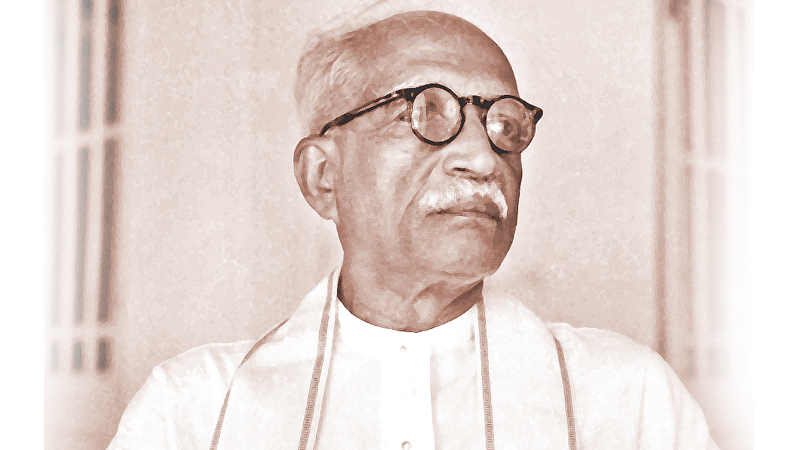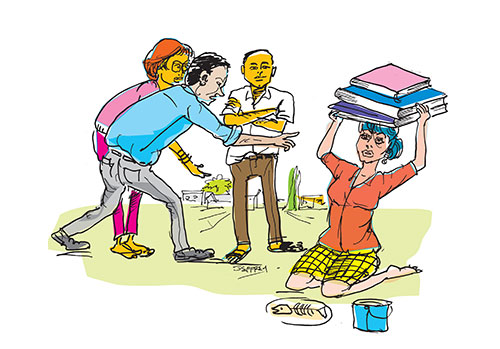by Erandika de Silva
It was an unswept corridor with poor ventilation and no fans or air-conditioning, hellish in the scorching Jaffna weather. I see students with disabilities taking exams in the corridor outside of the New Exam Hall, in the Faculty of Arts, at the University of Jaffna. For four years, I was tormented by the sight of this spatial dichotomy: The exam hall was dedicated to students without disabilities who took exams in the comfort of fans (or more seldomly, air-conditioning ) while the corridor was the (un)official exam venue for visually-impaired students to whom the invigilators read out the paper aloud during the exam due to the unavailability of Braille transcribed exam papers. These students were placed in the corridor so that other students were not disturbed during the process. There is something fundamentally wrong with this. Why cannot these students be placed in a classroom instead of a corridor? And a larger question is why these students, along with others with disabilities, are excluded from university spaces?
Exam papers for visually-impaired students (in the Faculty of Arts) were not Braille-typed until 2023 when this concern was raised by one of my colleagues. Apparently, there was no policy or regulation, among the zillion exam by-laws and regulations that govern examinations at state universities, mandating exams to be transcribed in Braille for visually-impaired students. They had to listen to the invigilator reading out the paper, and then write down the answers to the questions. For instance, an exam where there was a question involving a comprehension passage, these students could not go back and forth between the exam paper and their answers. The only way to revisit the passage was by requesting the invigilator to read it out again. It is not as easy as it sounds. First, the student has to ask the invigilator to read out the question, recall the passage, recall the paragraph where the answer was [all while retaining the question in mind], request the invigilator to read out the paragraph/a couple of paragraphs, request to repeat if it was not clear or if they were not sure, retain the information in memory and formulate an answer. While other students can revisit the passage at any time, the level of effort these students needed to put into writing an exam was several times more.
Students with disabilities are given extra time to complete the exam but the assessment format, grading system or the rubric for marking is the same as those used for students without disabilities. It is fundamental that we recognize that the performance of these two groups of students in exams is incommensurable as long as assessment methods and formats are not redesigned to cater to the needs of students with disabilities.
Looking back, I remember my first encounter with a student with a disability at the University of Jaffna. It was a day when the elevator in the Faculty of Arts went out of order. Two students holding either side of a wooden chair carried another student upstairs just in time for class. This building does not have wheelchair accessibility and the elevator is the only way for students with mobility impairments to access the building. Due to accessibility issues, most students are unable to offer subjects that are taught in lecture rooms without disability accessibility. Related to this concern, most state universities in Sri Lanka do not even have disability accessible washrooms. At least, in Arts faculties we see students with disabilities. How many students with disabilities enter STEM courses? Like in many other middle- to low-income countries, STEM courses in Sri Lanka do not welcome students with disabilities. In fact, primary and secondary education systems are designed in such a way that they make it very, very difficult for students with disabilities to enter the science and technology streams.
Coming back to the anecdotes; what do they tell us? Who is the problem? Lack of funding for infrastructure development is the scapegoat for the lack of disability inclusion. But the problem is that the systems we live in do not recognize their systemic incapacities, and systemic and structural violence manufactures and reproduces disability. For instance, funds are made available for various events, including religious and cultural celebrations, all year long, but accommodation needs, such as disability accessibility washrooms, are either never funded or funded only by third-parties. Disability is not biological in that sense, but rather a social construct since the systems we live in do very little to empower persons with disability. The social institutions around us do not have built-in mechanisms to provide inclusive spaces, opportunities and growth for persons with disabilities. Disability comes in various forms and there is little thought or conversation about a ‘no detriment’ approach or the safety nets available to students with intellectual disabilities and special learning needs. ‘No detriment’ approach needs to be recognized as a student right that may help address situations that can negatively impact learning and assessment.
In my (limited) experience, both as a student and an academic in the Sri Lankan university system, I have not come across students communicating or reporting intellectual disabilities to lecturers. Again, even if there were students with such disabilities, I may not be privy to such information and, of course, why should I be? But the caveat is that even if students with physical disabilities are able to enter the higher education system, students with intellectual or learning disabilities barely make it to even high school levels of education. . The education system in Sri Lanka is rigged in such a way that it filters out students with intellectual or learning disabilities.
One of my friends who studied Engineering at a leading university in Sri Lanka suffered from narcolepsy. Perpetually failing his exams due to his medical condition and attempting suicide a number of times, it took nearly two years for him to get a diagnosis. There is no safety net or a ‘no detriment’ approach for the inclusion and academic success of such students. Will universities reverse their grades or provide alternative modes of assessment for the time they lose while struggling for a diagnosis? Although narcolepsy is not an intellectual disability, we could use it as an analytical lens to understand the challenges faced by students with disabilities.
Initiatives such as IncEdu (Developing Inclusive Education for Students with Disability in Sri Lankan Universities), a collaboration with three European universities and three Sri Lankan universities, have been introduced to the state university system. According to a flyer on the internet, their objective is “to maximize the opportunities for students with disabilities, ultimately reaching the apex of “full inclusion” in all fields…” The term “full inclusion” is vague and remains undefined in the flyer. A good start for universities might be to establish centres for disability inclusion both as student services and research centres to conduct needs assessments and to study disability inclusion to cater to students with special learning needs.
I had the shock of my life once when I attended a public guest lecture at the University of Jaffna, by a reputed professor who works on urban planning. When I asked a question about how town and country planners responded to disability inclusion in their work, his response was that requests for inclusion needed to come from those populations who required special inclusion. It may seem to make sense since, in the academy, we speak of representation and re-presentation and how one cannot speak for others, and that the need for representation should arise from those who need representation. Yet, the reality on the ground demands otherwise; once a city or building is built in a poverty-stricken country like Sri Lanka, there is little to no room for creating accessibility options later on. What is practical is for urban planners, architects and engineers to do needs assessments with relevant communities before they implement urban development projects instead of making persons with disabilities lobby for changes once cities and constructions are completed. Are Disabled Persons (Accessibility) Regulations of 2006 that set out standards for construction followed at all times?
Reverting to my topic on the lack of disability justice in Sri Lanka’s higher education system, my contention is that disability justice and inclusion ought to occupy a fundamental place in educational reform. Without any efforts for disability justice, education is just a hollow goal that widens the gap between the socially privileged and under-privileged, pushing persons with disabilities to further levels of marginalization. The problem is not students with disabilities but universities with disabilities; universities that are blind and deaf to the needs for inclusion of persons with disabilities.



